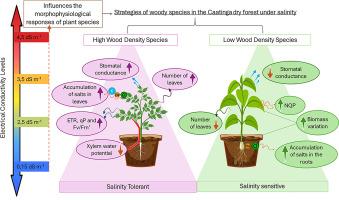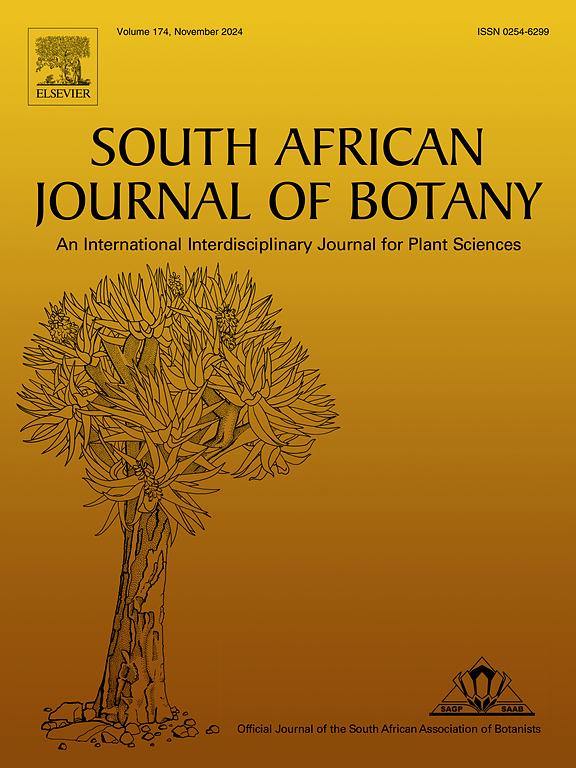本土半干旱物种不同功能群植物的盐胁迫耐受策略各不相同
IF 2.7
3区 生物学
Q2 PLANT SCIENCES
引用次数: 0
摘要
干旱地区盐度的升高加剧了该地区的荒漠化,因此更有必要确定耐盐物种。对植物功能群的调查可以明确适应策略,但在盐碱环境中,这种调查尚未进行。我们的目标是研究卡廷加植物的不同功能群如何应对盐碱压力的增加。对高木质密度(HWD)落叶物种(Myracrodruon urundeuva 和 Bauhinia cheilantha)和低木质密度(LWD)落叶物种(Amburana cearenses 和 Pseudobombax marginatum)的植物进行了评估。盐浓度(NaCl)分别为 0.15、2.5、3.5 和 4.5 dS m-1,施用 90 天。采用 2 × 2 × 4 的完全随机设计,5 次重复。实验结束后,对生长、气孔导度(gs)、水势(Ψxylem)、叶绿素荧光、盐分含量和酶活性进行了分析。对数据进行了多项式回归分析和 Tukey 检验(5%)。HWD 组被归类为耐盐碱组,其 gs 值(300 mmol m-2s-1)、Ψxylem 变化(70 %)、光系统 II 效率、叶片数量和叶片中盐分积累(K+ = 70 %、Na+ = 18 % 和 Cl- = 52.5 %)均较高。另一方面,LWD 组被归类为对盐度中度敏感,随着盐度的增加,其生长和生物量大幅减少,茎(Cl- = 136 %)和根(Na+ = 44 %;Cl- = 45 %)中的离子积累,酶活性提高(45 %)。不同功能组的卡廷加苗对盐胁迫的耐受策略不同。HWD 组对盐碱的耐受性更强,是盐碱化地区恢复的良好选择。本文章由计算机程序翻译,如有差异,请以英文原文为准。

Salt stress tolerance strategies vary between different functional groups of plants of native semi-arid species
The increase in salinity in dry regions has contributed to the desertification of areas, increasing the need to identify tolerant species. The investigation of functional groups of plants clarifies adaptation strategies; however, in a saline environment, it has not yet been explored. The objective was to investigate how different functional groups of Caatinga plants respond to increased saline stress. Plants of deciduous species with high wood density (HWD) (Myracrodruon urundeuva and Bauhinia cheilantha), and deciduous species with low wood density (LWD) (Amburana cearenses and Pseudobombax marginatum) were evaluated. The saline concentrations (NaCl) were 0.15; 2.5; 3.5 and 4.5 dS m-1 applied for 90 days. A completely randomized design was adopted in a 2 × 2 × 4 factorial scheme with five replications. At the end of the experiment, growth, stomatal conductance (gs), water potential (Ψxylem), chlorophyll fluorescence, salt content and enzymatic activity were analyzed. The data were subjected to polynomial regression analysis and Tukey test (5 %). The HWD group was classified as salinity tolerant and presented high values of gs (300 mmol m-2s-1), variation in Ψxylem (70 %), efficiency of photosystem II, number of leaves, and accumulation of salts in the leaves (K+ = 70 %, Na+ = 18 %, and Cl- = 52.5 %). On the other hand, the LWD group was classified as moderately sensitive to salinity and showed a large reduction in growth and biomass with increased salinity, accumulation of ions in stem (Cl- = 136 %) and root (Na+ = 44 %; Cl- = 45 %), and higher enzymatic activity (45 %). Tolerance strategies to saline stress differ between different functional groups of Caatinga seedlings. The HWD group is more tolerant to salinity and represents a good alternative for the recovery of salinized areas.
求助全文
通过发布文献求助,成功后即可免费获取论文全文。
去求助
来源期刊

South African Journal of Botany
生物-植物科学
CiteScore
5.20
自引率
9.70%
发文量
709
审稿时长
61 days
期刊介绍:
The South African Journal of Botany publishes original papers that deal with the classification, biodiversity, morphology, physiology, molecular biology, ecology, biotechnology, ethnobotany and other botanically related aspects of species that are of importance to southern Africa. Manuscripts dealing with significant new findings on other species of the world and general botanical principles will also be considered and are encouraged.
 求助内容:
求助内容: 应助结果提醒方式:
应助结果提醒方式:


